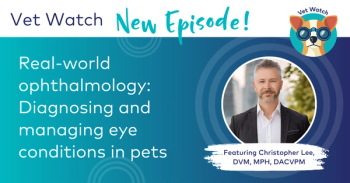
Just Ask the Expert: Corneal problems in a young pup
Dr. Juliet Gionfriddo examines a case of a pup with a rough cornea with increased opacity.
Dr. Gionfriddo welcome ophthalmology questions from veterinarians and veterinary technicians.
A 45-day-old male cocker spaniel was presented for its first puppy examination. During the clinical examination, I noticed a lesion on the dog's right eye (see photo). The cornea was rough and had increased opacity, especially in the center where the color was white and blood vessels were noted. The person who sold the dog to the owners told the them the dog had had this lesion since he opened his eyes and that it would go away.
Schirmer tear test (STT) results were 6 mm/min in the right eye and 8 mm/min in the left eye. Based on the clinical signs and the STT results, I diagnosed keratoconjunctivitis sicca (KCS). Initial treatment consisted of tobramycin eye drops in the affected eye three times a day and an ophthalmic lubricant (Liposic—Bausch & Lomb) in both eyes three times a day.
One week later, the dog was reevaluated. Corneal opacity was slightly reduced on the periphery, but the blood vessels were still obvious. The treatment was changed to eye drops containing tobramycin and diclofenac sodium (Tobrafen—Alcon) given on a tapered dose (three times a day for four days, twice a day for four days, and once a day for 4 days) in the right eye and a cyclosporine ointment given once a day in both eyes. The Liposic was continued in both eyes three times a day. On reexamination about one week later, the opacity and blood vessels were slightly reduced in the dog's right eye.
Do you think the improvement is satisfactory so far? Should we change the treatment to eye drops containing an antibiotic and corticosteroids? The puppy is still unvaccinated, so would the use of corticosteroid or cyclosporine eye drops affect vaccine efficacy? Should I expect complete resolution of the lesion in the right eye? We intend to repeat the STT three weeks after starting the cyclosporine treatment. If there is improvement in the STT results, how should I manage this condition thereafter in both eyes?
A. From your description of the case and the photographs you sent, it appears that the puppy may have had ophthalmia neonatorum, or neonatal conjunctivitis (an infection under the eyelids prior to their opening). This condition can lead to corneal ulceration (even to the point of rupture) and damage to the lacrimal glands. The lesion on the right cornea appears to be a healed corneal ulcer with associated corneal neovascularization. You fail to mention whether or not the cornea stained with fluorescein dye when you saw the puppy initially or upon the recheck.
Dr. Juliet R. Gionfriddo
THERAPY FOR KCS
Since the STT results were below the minimum normal values of 15 mm/min in both eyes, your diagnosis of secondary KCS was appropriate for this case. Your treatment with a topical antibiotic and an ocular lubricant was appropriate, but I might have added topical cyclosporine to the treatment regimen at this point. This would help produce tears and act as an antifibroblastic agent to reduce scarring. It is important to use topical cyclosporine as early as possible in KCS cases as it will help prevent further damage to the lacrimal glands and get them geared up to produce tears as soon as possible.
It does appear that the treatment is satisfactory so far. I think you will see continued improvement (i.e. decreased opacity and neovascularization) as the dog receives the cyclosporine for a longer period of time. Your plan to recheck the STT values is good, but you do not want to discontinue the cyclosporine even if the values have increased to within normal limits. The cyclosporine may be a lifelong therapy because the infection may have caused marked damage to the lacrimal glands. If the puppy produces large amounts of tears in the future, the frequency of the cyclosporine may be reduced.
Corticosteroids could be added to the treatment regimen to help reduce the clinical signs of the disease more rapidly, but make sure to stain the eyes with fluorescein to ensure there are no corneal ulcers in either eye before starting topical corticosteroids. But corticosteroid therapy is not necessarily needed since once the inciting cause has been removed, the secondary signs will ameliorate.
Continued use of antibiotics is important only until the STT values return to normal. Tears provide much protection to the eye, both physically and through their immune components, and as long as the tears are reduced there is increased likelihood of infection. Unless there is an active infection, your objective for antibiotic therapy is only to reduce the bacterial load in the eye, so it does not really matter which antibiotic is chosen. Preferably a broad-spectrum, inexpensive medication should be used over an antibiotic such as a fluoroquinolone.
The continued use of a lubricant is fine until the STT values improve. Neither topical corticosteroids or cyclosporine will affect vaccine efficacy, nor would the original ocular problem. Please vaccinate the puppy.
Complete clearing of the right cornea is unlikely to occur because it appears that the cornea is scarred. Once the linear arrangement of the collagen fibers of the cornea are disrupted and replaced with fibrous tissue, they will no longer transmit light as effectively. However, once the neovascularization, edema, and inflammation disappear, the cornea will remodel to some extent, and vision is likely to improve.
PREVENTION
As far as the initiating cause of this disorder—ophthalmia neonatorum—it is important to recognize and treat it early to prevent the damage present in this puppy. At the first sign of any discharge from under the sealed eyelid of a newborn puppy, the eyelid should be opened, and the eye should be lavaged with eyewash. Topical antibiotics such as a triple antibiotic solution should be given at least three times a day until no signs of ocular discharge or hyperemia of the conjunctiva are present. Opening the eyes early will not harm them.
Juliet R. Gionfriddo, DVM, MS, DACVO
Department of Clinical Sciences
College of Veterinary Medicine and Biomedical Sciences
Colorado State University
Fort Collins, CO 80523
Newsletter
From exam room tips to practice management insights, get trusted veterinary news delivered straight to your inbox—subscribe to dvm360.






